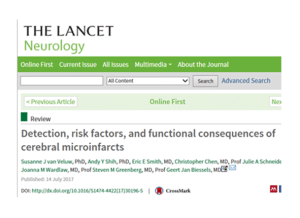 „α-Synuclein transfer between neurons and astrocytes indicates that astrocytes play a role in degradation rather than in spreading“ has been published in Acta Neuropathologica. This work was supported in part by JPND through the NeuTARGETS project, selected in the 2013 Cross-Disease Analysis call.
„α-Synuclein transfer between neurons and astrocytes indicates that astrocytes play a role in degradation rather than in spreading“ has been published in Acta Neuropathologica. This work was supported in part by JPND through the NeuTARGETS project, selected in the 2013 Cross-Disease Analysis call.
Author Archives: jpnd
In a new study published in Molecular Psychiatry, researchers have measured how deposits of the pathological protein tau spread through the brain over the course of Alzheimer’s disease. Their results show that the size of the deposit and the speed of its spread differ from one individual to the next, and that large amounts of tau in the brain can be linked to episodic memory impairment.
Even in a very early phase of Alzheimer’s disease there is an accumulation of tau in the brain cells, where its adverse effect on cell function causes memory impairment. It is therefore an attractive target for vaccine researchers. For the present study, the research team used PET brain imaging to measure the spread of tau deposits as well as the amyloid plaque associated with Alzheimer’s disease, and charted the energy metabolism of the brain cells. They then examined how these three parameters changed over the course of the disease.
The study included 16 patients at different stages of Alzheimer’s disease. The patients were given a series of neurological memory tests and underwent PET scans at 17-month intervals. While all 16 participants had abundant amyloid plaque deposition in the brain, the size and speed of spread of their tau deposits differed significantly between individuals. A notable correlation between the size of the deposit and episodic memory impairment was also found, the researchers said, noting that this could explain differences in disease progression across patients.
Paper: „Longitudinal changes of tau PET imaging in relation to hypometabolism in prodromal and Alzheimer’s disease dementia”
Reprinted from materials provided by Karolinska Institutet.
 „KMT2A and KMT2B Mediate Memory Function by Affecting Distinct Genomic Regions“ has been published in Cell Reports. This work was supported in part by JPND through the RiMod-FTD project, selected in the 2012 Risk Factors call.
„KMT2A and KMT2B Mediate Memory Function by Affecting Distinct Genomic Regions“ has been published in Cell Reports. This work was supported in part by JPND through the RiMod-FTD project, selected in the 2012 Risk Factors call.
A new article published in JAMA Neurology compares survival rates among patients with synucleinopathies, including Parkinson’s disease, dementia with Lewy bodies, Parkinson’s disease dementia and multiple system atrophy with parkinsonism, with individuals in the general population.
The population-based study included all the residents of Minnesota’s Olmsted County and identified 461 patients with synucleinopathies and 452 patients without for comparison.
From 1991 through 2010, the 461 patients with a synucleinopathy diagnosis included 309 with Parkinson’s disease, 81 with dementia with Lewy bodies, 55 with Parkinson’s disease dementia and 16 with multiple system atrophy with parkinsonism. Parkinsonism was defined as the presence of at least 2 of 4 cardinal signs: rest tremor, bradykinesia, rigidity and impaired postural reflexes.
Of the 461 patients with synucleinopathies, 316 (68.6 percent) died during follow-up, while among the 452 participants used for comparison, 220 (48.7 percent) died during follow-up.
Overall, patients with synucleinopathies died about two years earlier than participants without in the comparison group. The highest risk of death was seen among patients with multiple system atrophy with parkinsonism, followed by patients with dementia with Lewy bodies, Parkinson’s disease dementia and Parkinson’s disease, according to the results.
Paper: „Survival and Causes of Death Among People With Clinically Diagnosed Synucleinopathies With Parkinsonism”
Reprinted from materials provided by The JAMA Network.
 „The role of de novo mutations in the development of amyotrophic lateral sclerosis“ has been published in Human Mutation. This work was supported in part by JPND through the STRENGTH project, selected in the 2012 Risk Factors call, and the SOPHIA project, selected in the 2011 Biomarkers call.
„The role of de novo mutations in the development of amyotrophic lateral sclerosis“ has been published in Human Mutation. This work was supported in part by JPND through the STRENGTH project, selected in the 2012 Risk Factors call, and the SOPHIA project, selected in the 2011 Biomarkers call.
In a new paper, researchers have demonstrated that measuring neurofilaments provides reliable confirmation of an ALS diagnosis.
Neurofilaments are structural proteins in the cytoskeleton, which are present in high concentrations in motor neurons. It has long been known that the lumbar fluid in ALS patients contains a higher concentration of neurofilaments, perhaps because they are released from sick motor neurons. Now, researchers have carried out detailed research into this phenomenon, which has been published in Neurology.
The scientists say that they have demonstrated that a particular kind of neurofilament (pNfH, phosphorylated neurofilament heavy) can be shown to markedly increase in ALS patients’ lumbar fluid.
The researchers have also demonstrated that there is a good correlation between the degree of neurofilament increase and the extent of the motor neuron loss. This indicates that the test reflects the underlying disease process. Whether the implementation of the test will also lead to a shorter time before diagnosis is currently still being researched.
This diagnostic test represents a significant step forward because valuable time is still lost at present in diagnosing ALS, with diagnosis currently taking an average of one year from the first symptoms. The researchers hope that these tests will allow treatment to be started sooner.
Paper: “Neurofilament markers for ALS correlate with extent of upper and lower motor neuron disease”
Reprinted from materials provided by VIB – Flanders Interuniversity Institute for Biotechnology.
 „Detection, risk factors, and functional consequences of cerebral microinfarcts“ has been published in The Lancet Neurology. This work was supported in part by JPND through the HARNESS project, selected in the 2016 Brain Imaging Working Groups call.
„Detection, risk factors, and functional consequences of cerebral microinfarcts“ has been published in The Lancet Neurology. This work was supported in part by JPND through the HARNESS project, selected in the 2016 Brain Imaging Working Groups call.
A research team has developed a novel measure of disease progression for Huntington’s disease (HD), enabling them to identify a genetic modifier associated with how rapidly the disease progresses.
The study was published in Lancet Neurology.
HD is a fatal neurological disease caused by a genetic mutation. Larger mutations are linked to rapidly progressing disease, but that does not account for all aspects of disease progression.
The research team used the high-quality phenotypic data from the intensively studied TRACK-HD cohort of people with the HD gene mutation. They established that different symptoms of disease progress in parallel, so they were able to combine the data from 24 cognitive, motor and MRI brain imaging variables to generate their progression score for genetic analysis.
They then looked for areas of the genome associated with their progression measure, and found a significant result in their sample of 216 people, which they then validated in a larger sample of 1773 people from a separate cohort, the European Huntington’s Disease Network (EHDN) REGISTRY study.
The genetic signal is likely to be driven by the gene MSH3, a DNA repair gene which has been linked to changes in size of the HD mutation. The researchers identified that a variation in MSH3 encodes an amino acid change in the gene. MSH3 has previously been extensively implicated in the pathogenesis of HD in both mouse and cell studies. The group’s findings may also be relevant to other diseases caused by repeats in the DNA, including some spinocerebellar ataxias.
Paper: “Identification of genetic variants associated with Huntington’s disease progression: a genome-wide association study”
Reprinted from materials provided by University College London.
 „Contribution to Alzheimer’s disease risk of rare variants in TREM2, SORL1 and ABCA7 in 1,779 cases and 1,273 controls“ will be published in the journal Neurobiology of Aging. This work was supported in part by JPND through the PERADES project, selected in the 2012 Risk Factors call.
„Contribution to Alzheimer’s disease risk of rare variants in TREM2, SORL1 and ABCA7 in 1,779 cases and 1,273 controls“ will be published in the journal Neurobiology of Aging. This work was supported in part by JPND through the PERADES project, selected in the 2012 Risk Factors call.
Researchers have found the first direct evidence that autoimmunity—in which the immune system attacks the body’s own tissues—plays a role in Parkinson’s disease, the neurodegenerative movement disorder. The findings raise the possibility that the death of neurons in Parkinson’s could be prevented by therapies that dampen the immune response.
The study was published in Nature.
Scientists once thought that neurons were protected from autoimmune attacks. However, in a 2014 study, the researchers demonstrated that dopamine neurons (those affected by Parkinson’s disease) are vulnerable because they have proteins on the cell surface that help the immune system recognize foreign substances. As a result, they concluded, T cells had the potential to mistake neurons damaged by Parkinson’s disease for foreign invaders.
The new study found that T cells can be tricked into thinking dopamine neurons are foreign by the buildup of damaged alpha-synuclein proteins, a key feature of Parkinson’s disease.
In the study, the researchers exposed blood samples from 67 Parkinson’s disease patients and 36 age-matched healthy controls to fragments of alpha-synuclein and other proteins found in neurons. They analyzed the samples to determine which, if any, of the protein fragments triggered an immune response. Little immune cell activity was seen in blood samples from the controls. In contrast, T cells in patients‘ blood samples, which had been apparently primed to recognize alpha-synuclein from past exposure, showed a strong response to the protein fragments. In particular, the immune response was associated with a common form of a gene found in the immune system, which may explain why many people with Parkinson’s disease carry this gene variant.
The researchers hypothesize that autoimmunity in Parkinson’s disease arises when neurons are no longer able to get rid of abnormal alpha-synuclein. The team is now analyzing these responses in additional patients, and are working to identify the molecular steps that lead to the autoimmune response in animal and cellular models.
Paper: “T cells of Parkinson’s disease patients recognize alpha-synuclein peptides”
Reprinted from materials provided by Columbia University Medical Center.
